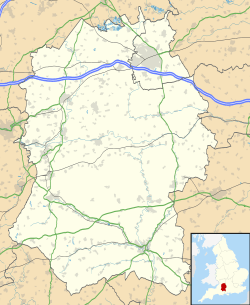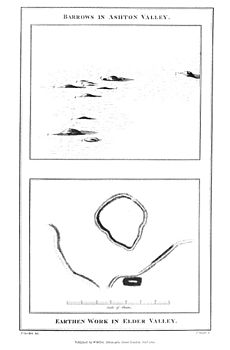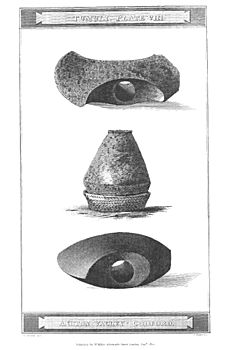Aston Valley Barrow Cemetery facts for kids
| Alternative name | Ashton Valley Barrow Cemetery |
|---|---|
| Location | Wiltshire |
| Region | Southern England |
| Coordinates | 51°11′07″N 2°01′48″W / 51.1853°N 2.0301°W |
| Type | Barrow cemetery |
| History | |
| Material | Chalk |
| Periods | Bronze Age |
| Site notes | |
| Archaeologists | Sir Richard Colt Hoare, W.F.Cunnington, L.Grinsell, Rev.E.H.Steele |
The Aston Valley Barrow Cemetery is an ancient burial ground from the Bronze Age. It is also known as Ashton Valley Barrow Cemetery. This site has a group of earth mounds called tumuli. These mounds are either "bowl barrows" or "bell barrows."
You can find this cemetery on the edge of Codford Down in Wiltshire, England. It's on the west side of the Chitterne Brook valley. Originally, there were ten bowl barrows and one bell barrow. However, some have been flattened by farming over time. Today, only the bell barrow and five bowl barrows are still visible.
Where is this Ancient Site?
This old burial site is close to other important ancient places. About 2 kilometers (1.2 miles) to the southeast is Codford Circle. This was an Iron Age hillfort or a large enclosed area. Knook Castle, another Iron Age hillfort, is about the same distance to the northwest.
What Did Archaeologists Find?
Archaeologists have dug up many interesting things at these barrows. They found cremated remains (ashes of people) from the Bronze Age. They also found some possible Saxon urns with cremations.
The first excavations were done by W.F. Cunnington in 1801. Sir R. Colt-Hoare recorded what they found. Later, Reverend E.H. Steele did more digs in 1957. Leslie Grinsell also helped connect the findings in 1957. Some of the burials and items were left where they were found. Others are now kept safe at the Wiltshire Museum in Devizes.
When Colt-Hoare and Cunnington dug in the 1800s, they found most of the items. But they didn't have a way to accurately tell the age of their finds. This was because the "three-age system" (Stone Age, Bronze Age, Iron Age) had not been invented yet. This made it harder for them to understand the history of what they found.
Exciting Discoveries in the Barrows
Each barrow at Aston Valley tells a unique story. Here are some of the cool things archaeologists discovered:
- Barrow A: This was the biggest barrow. Inside, they found the ashes of one main person in a large pot. They also found nine smaller pots with ashes and other burnt bones.
- Barrow D: This was the bell barrow. It had a ditch around it. Inside, they found cremated remains under an upside-down Bronze Age pot. They also found a special stone battle-axe or hammer.
- Barrow E: This barrow contained a cremation. Along with it, archaeologists found another battle axe made of a type of stone called granodiorite. They also found a bone point, which might have been part of a tool or weapon.
- Barrow F: This barrow was quite large. It held a primary cremation. Later, someone from the Saxon period was also buried there. They found a wooden bucket with bronze bands and what might have been a sword or spearhead.
- Other Barrows: Several other barrows (G, H, J, K, L) have been flattened by farming. However, records show they also contained cremations, sometimes in crushed pots. One even had a human burial in a wooden coffin.
These finds help us learn about how people lived and buried their dead thousands of years ago in the Bronze Age.




